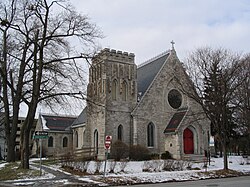| Grace Church | |
|---|---|
 | |
| Location | 819 Madison St, Syracuse, New York 13210 |
| Country | United States |
| Denomination | Episcopal Church (United States) |
| Website | gracesyracuse |
| Administration | |
| Division | Province II |
| Subdivision | Diocese of Central New York |
| Clergy | |
| Rector | Rev. Dr. Steve Moore |
Grace Episcopal Church | |
 | |
| Location | 819 Madison Avenue, Syracuse, New York |
| Coordinates | 43°2′44.08″N76°8′5.17″W / 43.0455778°N 76.1347694°W |
| Built | 1876 |
| Architect | Horatio Nelson White |
| Architectural style | Stone Gothic Revival |
| NRHP reference No. | 73001235 [1] |
| Added to NRHP | March 20, 1973 |
Grace Episcopal Church is an historic Episcopal parish in Syracuse, New York. The Gothic Revival building was designed by Horatio Nelson White and was built in 1876. [2] It is located at 819 Madison Avenue near Syracuse University. On March 20, 1973, it was listed on the National Register of Historic Places. [1]




